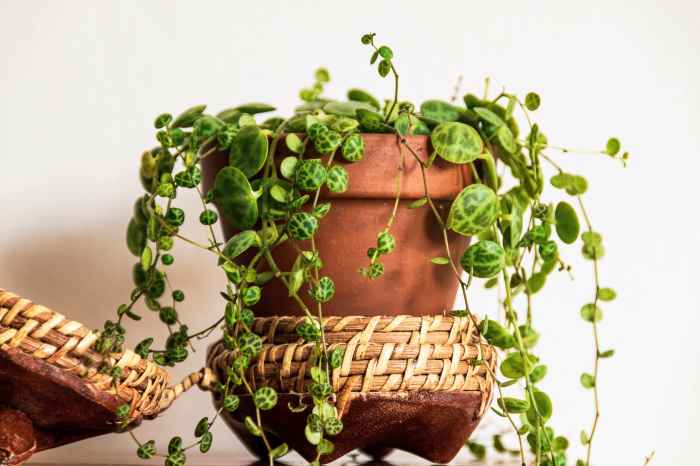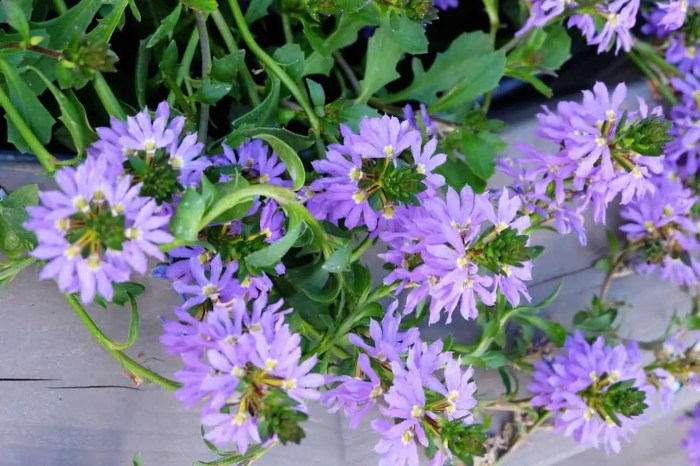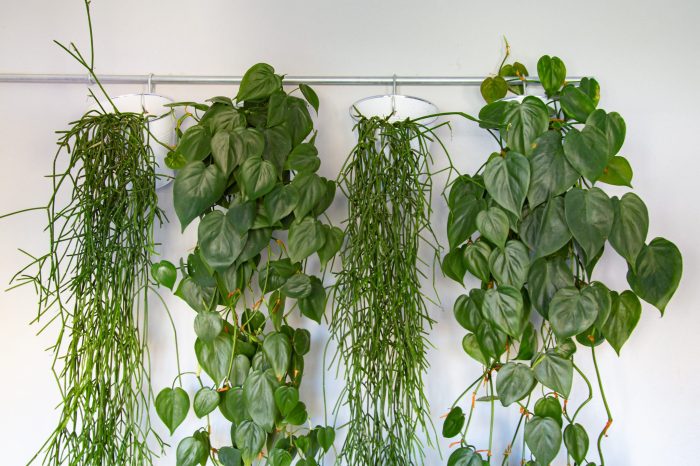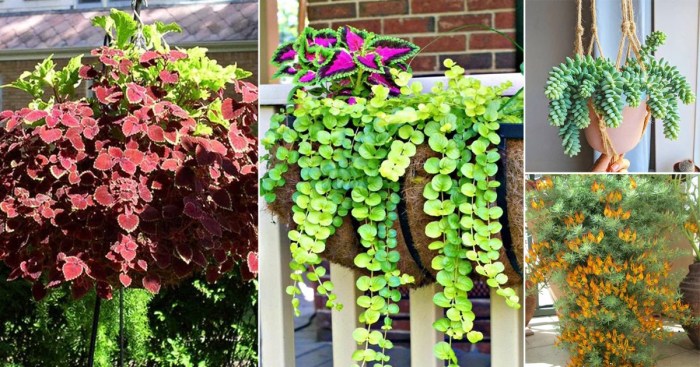Common trailing plants, with their graceful stems and cascading foliage, add a touch of elegance and charm to any garden or home. Whether used in hanging baskets, window boxes, or as groundcovers, these versatile plants offer a wide range of options for creative landscaping and décor.
From the delicate tendrils of ivy to the vibrant blooms of petunias, trailing plants come in a variety of shapes, sizes, and colors. They can be used to create a lush, cascading effect, soften hardscapes, or add a touch of color to shady areas.
Trailing Plant Varieties

Trailing plants, also known as cascading plants, add a touch of elegance and lushness to any indoor or outdoor space. These versatile plants come in a wide variety of species, each with unique growth habits and characteristics.
Trailing plants, renowned for their cascading foliage, bring a touch of greenery to any indoor space. Among the most popular trailing plants, those that thrive in low light conditions are particularly sought after. For those seeking the best trailing indoor plants low light, an extensive guide can be found here . These low-maintenance plants add a lush, verdant touch to any dimly lit corner, bringing the beauty of nature indoors.
Common trailing plants include:
- Spider plant( Chlorophytum comosum): A popular choice for hanging baskets, spider plants produce long, narrow leaves with variegated edges.
- Pothos( Epipremnum aureum): Known for its heart-shaped leaves, pothos is a low-maintenance plant that can tolerate low light conditions.
- Ivy( Hedera helix): A classic trailing plant, ivy has glossy, lobed leaves and can grow up to 100 feet long.
- String of pearls( Senecio rowleyanus): A unique succulent, string of pearls has small, round leaves that resemble strings of pearls.
- Creeping Jenny( Lysimachia nummularia): A fast-growing groundcover, creeping Jenny has bright green, round leaves and can quickly fill in empty spaces.
- Tradescantia( Tradescantia zebrina): A vibrant plant with striped leaves, tradescantia is a popular choice for terrariums and hanging baskets.
- Peperomia( Peperomia obtusifolia): A compact trailing plant, peperomia has thick, fleshy leaves and can tolerate dry conditions.
- Asparagus fern( Asparagus setaceus): A graceful plant with feathery foliage, asparagus fern is a good choice for adding texture and height to arrangements.
- Swedish ivy( Plectranthus verticillatus): A trailing plant with scalloped leaves, Swedish ivy is known for its ability to purify the air.
- Trailing rosemary( Rosmarinus officinalis): A culinary herb with trailing stems, trailing rosemary is a fragrant and flavorful addition to any garden.
The growth habits of trailing plants vary greatly, from fast-growing vines to slow-growing groundcovers. Some plants have trailing stems that can reach several feet in length, while others have more compact, cascading growth. The leaf shape and size also vary widely, from small, round leaves to large, variegated leaves.
Trailing plants can add a touch of elegance and beauty to any indoor or outdoor space. They are relatively easy to care for and can tolerate a variety of light conditions. With so many different species to choose from, there is sure to be a trailing plant that is perfect for any home or garden.
Table of Common Trailing Plants
| Plant Name | Botanical Name | Growth Habit | Leaf Characteristics |
|---|---|---|---|
| Spider plant | Chlorophytum comosum | Trailing | Long, narrow leaves with variegated edges |
| Pothos | Epipremnum aureum | Trailing | Heart-shaped leaves |
| Ivy | Hedera helix | Trailing | Glossy, lobed leaves |
| String of pearls | Senecio rowleyanus | Trailing | Small, round leaves that resemble strings of pearls |
| Creeping Jenny | Lysimachia nummularia | Trailing | Bright green, round leaves |
| Tradescantia | Tradescantia zebrina | Trailing | Striped leaves |
| Peperomia | Peperomia obtusifolia | Trailing | Thick, fleshy leaves |
| Asparagus fern | Asparagus setaceus | Trailing | Feathery foliage |
| Swedish ivy | Plectranthus verticillatus | Trailing | Scalloped leaves |
| Trailing rosemary | Rosmarinus officinalis | Trailing | Trailing stems with fragrant, flavorful leaves |
Trailing Plant Care
Trailing plants, with their graceful cascading foliage, add a touch of elegance to any indoor or outdoor space. However, to thrive, these plants require specific care and attention. Here’s a comprehensive guide to ensure your trailing plants flourish:
Light Requirements
Most trailing plants prefer bright, indirect light. Avoid placing them in direct sunlight, as this can scorch their leaves. East- or west-facing windows are ideal locations for these plants.
Water Needs
Trailing plants generally prefer moist soil but not soggy conditions. Allow the top inch of soil to dry out before watering. Overwatering can lead to root rot, while underwatering can cause wilting.
Soil Preferences
Well-draining soil is essential for trailing plants. A mixture of potting soil, perlite, and peat moss provides good drainage and aeration.
Propagation and Pruning
Trailing plants can be easily propagated by stem cuttings. Take a 4-6 inch cutting from a healthy stem and root it in water or moist soil. Pruning helps maintain the plant’s shape and encourages new growth. Remove any dead or damaged leaves and trim back overgrown stems.
Troubleshooting Common Problems
- Pests:Aphids, mealybugs, and spider mites can infest trailing plants. Treat infestations promptly with insecticidal soap or neem oil.
- Diseases:Fungal diseases like powdery mildew and botrytis can affect trailing plants. Improve air circulation and avoid overwatering to prevent these issues.
- Nutrient Deficiencies:Yellowing leaves can indicate a nitrogen deficiency. Fertilize the plant regularly with a balanced liquid fertilizer.
Trailing Plant Care Summary
- Light:Bright, indirect light
- Water:Water when the top inch of soil is dry
- Soil:Well-draining potting mix
- Propagation:Stem cuttings
- Pruning:Remove dead leaves and trim overgrown stems
Trailing Plant Uses

Trailing plants offer a versatile and captivating way to enhance the beauty of both indoor and outdoor spaces. Their cascading foliage and vibrant hues bring a touch of elegance and natural charm to any setting.
Landscaping Applications
In landscaping, trailing plants serve a multitude of purposes. They can be used to:
Create Hanging Baskets
Trailing plants are perfect for creating lush and colorful hanging baskets that add vertical interest to patios, balconies, and porches.
Common trailing plants, known for their cascading foliage, add a touch of elegance to any room. To showcase their beauty, best indoor plant hangers come in a variety of styles and materials, allowing you to find the perfect complement for your plants and decor.
With these hangers, trailing plants can gracefully adorn walls, ceilings, and shelves, creating a lush and inviting atmosphere.
Fill Window Boxes
Their cascading foliage creates a stunning display when planted in window boxes, adding a touch of nature to windowsills and brightening up the exterior of homes.
Cover Ground
As groundcovers, trailing plants form a dense mat that suppresses weeds and adds visual appeal to slopes, garden beds, and pathways.
Create Vertical Gardens
Trailing plants can be trained to climb trellises or walls, creating living tapestries that add depth and texture to vertical surfaces.
Common trailing plants are often sought after for their cascading foliage and graceful growth habit. They add a touch of elegance and greenery to any space. If you’re looking to add some vertical interest to your indoor décor, consider best hanging vine plants indoor . These plants are perfect for hanging baskets or trellises, and their long, trailing stems will create a beautiful and dramatic effect.
Common trailing plants such as English ivy, pothos, and spider plants are easy to care for and can thrive in a variety of indoor environments.
Home Décor Applications
Within homes, trailing plants bring a touch of greenery and tranquility to any room. They can be used to:
Add Greenery to Shelves and Tables
Trailing plants add a touch of life to shelves and tables, creating a cozy and inviting atmosphere.
Decorate Mantles and Fireplaces
Their cascading foliage adds a touch of elegance to mantles and fireplaces, creating a focal point in any living space.
Create Living Wall Art
Trailing plants can be arranged on walls to create unique and eye-catching living wall art that brings the outdoors in.
Hang from Macrame Hangers
Macrame hangers add a bohemian touch to trailing plants, creating a whimsical and stylish display.
Table: Trailing Plant Uses
| Use | Description | Examples | Benefits ||—|—|—|—|| Hanging Baskets | Cascading plants create a lush and colorful display | Petunias, begonias, fuchsias | Vertical interest, adds color || Window Boxes | Foliage creates a stunning display | Geraniums, lobelia, alyssum | Brightens exterior, adds nature || Groundcovers | Dense mat suppresses weeds, adds appeal | Creeping Jenny, ivy, vinca | Erosion control, low maintenance || Vertical Gardens | Plants climb trellises or walls | Pothos, philodendron, ivy | Adds depth, texture, purifies air || Shelf and Table Decor | Adds greenery, creates ambiance | Ferns, succulents, spider plants | Cozy atmosphere, air purification || Mantle and Fireplace Decor | Foliage adds elegance | String of pearls, heartleaf philodendron | Focal point, adds charm || Living Wall Art | Plants arranged on walls | Moss, air plants, succulents | Unique display, brings outdoors in || Macrame Hangers | Adds bohemian touch | String of hearts, maidenhair fern | Whimsical, stylish display |
Trailing Plant Design

Incorporating trailing plants into garden designs offers a wealth of opportunities to create visual interest, texture, and movement. These versatile plants cascade gracefully over edges, softening hardscapes, and adding a touch of whimsy to any outdoor space.
Choosing the right trailing plants for your design style is crucial. Cottage gardens thrive with rambling roses, clematis, and honeysuckle, while modern landscapes call for sleek and architectural plants like trailing rosemary and sedums. Vertical gardens benefit from trailing plants like ivy and ferns, which create a lush, green tapestry.
Design Principles
When designing with trailing plants, consider the following principles:
- Color Combinations:Combine trailing plants with contrasting or complementary colors to create eye-catching displays. For example, pair pink geraniums with white alyssum or purple verbena with yellow lantana.
- Height Variation:Use trailing plants of different heights to create a layered effect. Taller plants can provide a backdrop for shorter varieties, while cascading plants can soften the edges of raised beds or containers.
- Texture Contrast:Mix trailing plants with varying textures to add depth and interest. For instance, combine smooth-leaved ivy with the velvety texture of lamb’s ear or the frilly foliage of ferns.
Focal Points, Common trailing plants
Trailing plants can become stunning focal points when used strategically. Plant a cascading vine over an archway or pergola to create a dramatic entrance. Use a trailing groundcover to draw attention to a water feature or sculpture. By positioning trailing plants in prominent locations, you can create eye-catching accents that enhance the overall flow of your garden.
Softening Hardscapes
Trailing plants are invaluable for softening the hard lines of patios, walls, and fences. Plant them along the edges of pathways or use them to cascade over retaining walls. The lush foliage and graceful movement of trailing plants will create a welcoming and inviting atmosphere.
Trailing Plant Companions

Trailing plants, with their cascading foliage and blooms, add a touch of elegance and drama to any garden. Pairing them with suitable companion plants can enhance their beauty, improve their growth, and attract beneficial insects.
When selecting companion plants for trailing plants, consider factors such as growth habits, blooming periods, and soil preferences. Companion plants should complement the trailing plant’s form and provide contrasting colors or textures. They can also improve soil health, attract pollinators, and deter pests.
Suitable Companion Plants
- Groundcovers:Low-growing groundcovers, such as creeping Jenny or thyme, can help suppress weeds and create a lush backdrop for trailing plants.
- Bulbs:Spring-blooming bulbs, such as tulips or daffodils, can provide a burst of color beneath trailing plants that bloom later in the season.
- Annuals:Colorful annuals, such as petunias or lobelia, can add vibrant hues and attract pollinators.
- Perennials:Perennial companions, such as hostas or ferns, can provide year-round interest and contrast with the trailing plant’s foliage.
Here are some successful trailing plant and companion plant combinations for different garden settings:
| Trailing Plant | Companion Plant | Benefits | Planting Tips |
|---|---|---|---|
| Ivy | Creeping Jenny | Weed suppression, lush backdrop | Plant ivy on a trellis or wall and let it cascade over creeping Jenny. |
| Petunia | Tulips | Spring color, contrast | Plant tulips in the fall and petunias in the spring. |
| Lobelia | Hosta | Pollinator attraction, year-round interest | Plant lobelia in a hanging basket above a hosta. |
| Fern | Thyme | Pest deterrence, contrasting texture | Plant thyme around the base of a fern. |
Closing Notes: Common Trailing Plants

With proper care and attention, common trailing plants can thrive in a variety of environments, adding beauty and interest to any space. Whether you’re a seasoned gardener or just starting out, incorporating these versatile plants into your landscaping or home décor is a surefire way to enhance the visual appeal of your surroundings.
FAQ Guide
What are the most popular common trailing plants?
Some of the most popular common trailing plants include ivy, petunias, vinca, lobelia, and trailing lantana.
How much light do common trailing plants need?
Most common trailing plants prefer bright, indirect light, but some varieties can tolerate partial shade.
How often should I water common trailing plants?
Water common trailing plants when the top inch of soil feels dry to the touch.